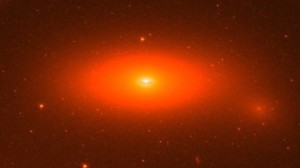NGC 1277 is a lenticular galaxy located in Perseus constellation. It lies at a distance of about 220 million light years from Earth.
The galaxy has an apparent visual magnitude of 14.7. It is notable for having an exceptionally massive supermassive black hole at its centre, one of the largest black holes ever found.
The black hole was discovered on November 28, 2012 by a team led by the Dutch astronomer Remco van den Bosch (Max Planck Institute of Astronomy) at the McDonald Observatory in Austin, Texas. The team discovered the supermassive black hole using the Hobby-Eberly Telescope and analyzing velocity dispersion measurements, and by looking at existing images of the galaxy from the Hubble Space Telescope.
BLACK HOLE
The black hole at the centre of NGC 1277 has 17 billion times the Sun’s mass, which corresponds to about 14 percent of the total stellar mass of the galaxy. Most supermassive black holes have up to 0.1 percent of the mass of their galaxies.
What is particularly notable about this black hole is that it was found at the centre of a lenticular galaxy, while most other exceptionally massive black holes have been discovered in large elliptical galaxies. In spite of the galaxy’s size, at the time of discovery, the supermassive black hole in NGC 1277 was the second biggest black hole known.
The black hole’s event horizon has a diameter 11 times larger than the orbit of Neptune around the Sun.
NGC 1277 is a relatively small galaxy, only 10 percent the mass and size of the Milky Way, yet the black hole is about 4,000 times larger than the one lying at the core of our galaxy. For comparison, the mass of the Milky Way’s central bulge is around 20 billion solar masses, and Sagittarius A*, the black hole in the centre of the Milky Way, located in the direction of Sagittarius constellation, has an estimated mass of about 4 million suns. This translates into only 0.02 percent of the Milky Way’s central bulge.
The ratio of the mass of the black hole found in NGC 1277 to that of its host galaxy is the largest one known, approximately 100 times greater than in typical galaxies. The discovery could lead to an introduction of a new class of galaxy-black hole systems, and provide insight into how galaxies are formed and how black holes evolve inside them.
The size of a black hole is generally believed to be linked with the size of the galaxy’s central region, as black holes are thought to evolve together with their host galaxies, but the discovery of this particular black hole calls that theory into question. Furthermore, the scientists discovered five other relatively small galaxies that may have enormous black holes in their central regions.
A theory proposed in February 2013 suggests that the black hole at the core of NGC 1277 may have been ejected from the giant galaxy NGC 1275 (Perseus A), located in the vicinity, in the aftermath of the merger of the two large elliptical galaxies that resulted in the formation of NGC 1275, and that the ejection of the black hole was a result of the gravitational radiation recoil that followed the merger of the two large black holes that followed the merger of the galaxies. The ejected black hole was then caught by the smaller galaxy, NGC 1277.
The closest black hole in size is located in the galaxy NGC 4486B, a satellite galaxy to Messier 87 (Virgo A) in Virgo constellation. It has 11 percent of the mass of its host galaxy’s central bulge.
FACTS
NGC 1277 was first documented on December 4, 1875 by Lawrence Parsons (4th Earl of Rosse), who observed it from Ireland.
The galaxy contains only old stars. The estimated age of the youngest stars inside the galaxy is 8 billion years, which is almost twice the age of the Sun. The reason why the galaxy has not been forming new stars in so long is uncertain.
NGC 1277
Location: 03h19m51.5s (right ascension), +41°34’25” (declination)
Distance: 220 million light years
Visual magnitude: 14.7
Other designations: PGC 012434, LGG 088
Constellation: Perseus
